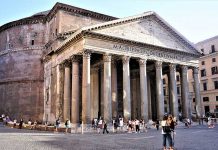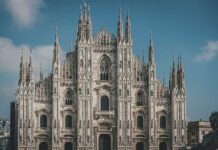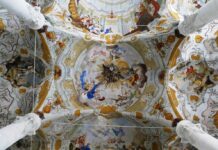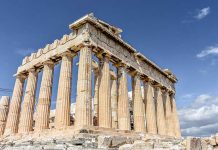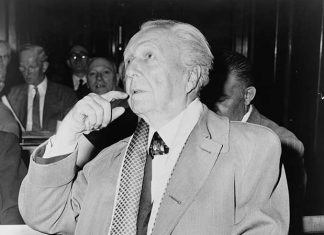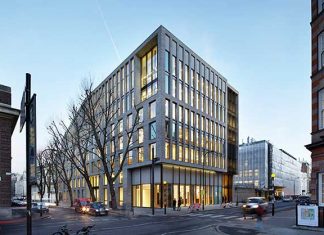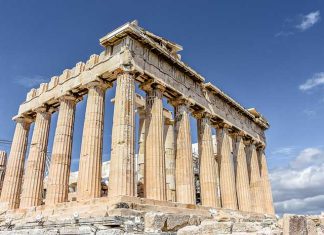In this article, which is based on the Renaissance architecture style, we would like to introduce the most important Renaissance architects and structures after briefly mentioning the birth of the Renaissance and its general architectural characteristics.
The middle age, one of the darkest periods of Europe, has found a way out thanks to the Renaissance. In this line, it has led up the way for a path from the illumination era to our modern world.
Meaning rebirth, Renaissance is the story of people who lost their individuality, importance, art and free thought. Then, it is the story of regaining these qualities under the leadership of artists.
Artists and scholars have been estranged from the religious focus, which is a part of the middle age culture. They analyzed antiquity deeply and upheld the idea that the Roman and Antique Greece civilizations had real values. Therefore, it’s not a surprise that Rome, one of the centers of the antique world, is the birthplace of the Renaissance.
Shortly, the Renaissance style born in Italy has been one of the most effective and large-scale architectural movements of all time.
Birth of Renaissance Idea
The fact that the Ottoman Empire conquered Constantinople and made it a Muslim city in 1453 triggered the start of a new era called the Renaissance.
After this case, the Roman Empire totally collapsed. Artists, architects and scholars, who lives in Constantinople before the Ottomans, had recorded the art, science and architecture of Greek civilization in these Greek-speaking lands and had a rich knowledge.
After the collapse of Rome, these intellectual people migrated to Western Europe. By this means, they took a chance to teach their knowledge and experiences to Italians.
The intellectual class consisted in light of this information constituted the first artists of the Renaissance. They have criticized the middle age with a rough side of tongue.
The pioneer society of the Renaissance has named that period between these two mountains as “medieval”, the dark period of Europe.
Renaissance was quite strong in Italy so much so that this age is also known as the Italian Renaissance. Italy was also the center of the Renaissance in the manner of finances.
There were many wealthy and noble families, merchants, aristocrats and guilds there. These families were paying Renaissance artists lots of money to represent their wealth and power through art.

The most famous families providing huge financial support to Renaissance architecture and art are the Medici family and the Pazzi family. As a result, this financial freedom has made artists braver and has eased the spreading of the movement.
Ten Books on Architecture
Perhaps the most important source of architects studying ancient period architecture is the Roman architect and author Vitruvius. The reason why Vitruvius got respect from Renaissance people was that he wrote the book “Ten Books on Architecture“.
This book includes extremely important knowledge about the ancient architecture of Rome. Architects have examined knowledge of the ancient age, such as styles, orders, ratios, proportions and adornments, from the book.
The main purpose of the Renaissance architecture style was to find a way out from the dark age with the help of the lightest era of history, the classical period. Moreover, it was to analyze Classicism with the questioning logic of a pure mind and resume developing the civilization.
Renaissance Architecture Characteristics
- Central plan setup
- The sacredness attributed to the circle shape
- Symmetry
- Domes with double shells
- Hemispherical domes
- Desire to achieve geometric perfection and integrity in design
- Reinterpreting ancient architectural forms
Early Renaissance Architecture Period
Renaissance architects were interested in the order and geometry of ancient Greek architecture. They have admired philosophers and mathematicians like Pisagor. That interest in mathematics, geometry and positive sciences has been reflected in architecture.
Renaissance architecture characteristics ensure a building design is technical, disciplined, rational and logical. Moreover, it featured human values, unlike Gothic architecture.
Florence Cathedral by Filippo Brunelleschi
Brunelleschi (1377-1446) is the first great architect of the Renaissance style. He used to live in Rome for a long time in order to examine the old Greek and Roman buildings and documents.
When he returned to Italy, he designed the huge dome of the Florence Cathedral. Then, this engineering marvel construction has been the most fascinating of Renaissance Architecture domes in history.
The town asked the architect to build a magnificent dome with a diameter of 42 meters on an octagonal body. Recognizing that it was impossible to construct this dome with known techniques, Brunelleschi invented a new system.
Instead of building a dome supported by wooden buttresses, he designed a structure with stone ribs that are visible from the outside. There were additional ribs hidden in the right and left sides of each of these main rib structures.
These ribs were rising from the bottom to the top of the dome and they were joined with the interconnections.
As the center where the dome sits is very wide, the architect sharpened and raised the dome. In this way, he managed to prevent the horizontal loads from collapsing the walls.
Consequently, he brought the largest and most magnificent dome in history to the silhouette of Florence and to the architecture. This add-on dome has made the building one of the most famous Renaissance architecture churches.
As additional knowledge, Brunelleschi’s other two important Renaissance-style buildings are the Pazzi Chapel and Santo Spirito in Florence.
Works of Leon Battista Alberti
Alberti (1404-1472), who is not a technical architect like Brunelleschi, was an architecture theoretician and one of the famous philosophers of his period.
He took the opportunity of being in Rome just like Brunelleschi, too. In this way, he examined ancient works closely. Alberti, who met many artists in Rome, also took courses about physics and natural sciences.
After Alberti read the “Ten Books on Architecture” of Vitruvius, he has become passionate about architecture. He has thought about house plans and has been interested in urban planning.
He defended the opinion that creating a circular (also hexagonal and square) center area in the structures. Moreover, he has fed from the proportional systems that he learned from Vitruvius’ book.
Alberti published a book made of 10 books in one piece “De re aedificatoria” in 1452 by emuling Vitruvius. He talks about structures, orders and his opinions about architecture in this work. He also added some important information narrated by Vitruvius in a more understandable way.
In his book, Alberti gave a place to the opinion of decorum and civitas as well. Decorum means building a structure through someone’s aims and Civitas means a city-based civilization.
Besides these theoretical works, Alberti designed some quite important Renaissance architecture examples. His most two famous Renaissance architecture works are Tempio Malatestiano and The Church of St. Andrea.
These designs and works of Brunelleschi and Alberti who are the greatest architects of the early Renaissance architecture period have been sources of inspiration for the next architects.
High Renaissance Architecture
At the end of the 15th century, Renaissance spread its popularity dramatically and it reached its peak in Europe. That period when great architects, such as Michelangelo, Leonardo da Vinci and Raphael produced works, is known as the High Renaissance period.
During the High Renaissance architecture era, when Italy suffered territorial losses, Florence was captured by a radical Christian. As a result of this case, the government suspended most artistic events. Moreover, the center of Renaissance and creative arts moved into Rome from Florence.
In this period, Da Vinci, known as the inheritor of Alberti, drew anatomical sketches in the light of knowledge that Vitruvius narrated.

“The Vitruvian Man” drawing of Leonardo Da Vinci represents the central stance of a man in the world. In the sketch, the Vitruvian Man, who had opened his arms and legs, created an ideal circle, with his navel exactly in the middle.
The circle was a symbol of sacred and absolute harmony in Renaissance period architecture. Leonardo designed circular domes by using this ideal circle as the keystone of plans in the churches he drew. But none of Leonardo’s drawings were applied.
Architectural historians think that the High Renaissance Architecture period ended with the death of Raphael in 1520. Its effects have influenced the illumination period and the industrial age. In conclusion, Renaissance formed one of the foundations of the alteration movement that will last for centuries.
Mannerism
Mannerism is the name that some art historians called the Late Italian Renaissance period in 1520-1530. Although it had a high popularity in this 10 years span, the style continued to influence architecture until the beginning of the Baroque architecture era at the end of the 16th century.
In the Mannerism period, the Renaissance style evolved into more decorative art. Strict norms of the early Renaissance gave place to an innovative and creative quest.
One key characteristic of Mannerism examples is pilasters that rise from the ground to the top of buildings. This feature, invented by Michelangelo, is also called the “giant order”. Furthermore, Mannerist architecture features visual tricks and unexpected use of Renaissance forms.
Some prominent Mannerist architects are Michelangelo, Andrea Palladio, Giulio Romano, Giacomo Barozzi da Vignola and Baldassare Peruzzi.
The most famous Mannerist buildings:
- Piazza del Campidoglio in Rome, Italy – Michelangelo
- Villa Farnese in Lazio, Italy – Giacomo Barozzi da Vignola
- Palazzo del Te in Mantua, Italy- Giulio Romano
- Pallazo Ducale in Mantua, Italy – Giulio Romano
- Pallazo Massimo alle Colonne in Rome – Baldassare Peruzzi
- St. John’s Co-Cathedral in Valetta, Malta – Girolamo Cassar
- Cathedral Basilica of Salvador in Brazil
- Vestibul of Laurentian Library in Florence, Italy – Michelangelo
You’ll learn detailed information about all these Mannerist buildings in the next sections. But before, we need to discover who the most famous Renaissance architects are.
Famous Renaissance Architects
1. Filippo Brunelleschi
| Birth date: | 1377-1446 |
| Birthplace: | Florence, Italy |
| Period: | Early Renaissance |
| Famous works: | Dome of Florence Cathedral, Pazzi Chapel |
Italian Flippo Brunelleschi is the first great architect of the Early Renaissance. He is also an engineer, planner, sculptor, artist and designer.
He is known for his innovative design for the Dome of Florence Cathedral. The beginning of the Renaissance architecture style is thought to be dated by Brunelleschi’s structures. This is why he is considered to be the founding father of Renaissance architecture.
In his early life, Brunelleschi worked as a sculptor and goldsmith. Then, he went to Rome in 1402-1404 with Donatello to study ancient monuments.
Thanks to this technical visit to Rome, he reinterpreted classical Roman architecture by doing a rational analysis and displaying an innovative attitude.
Important architectural works of Brunelleschi are:
- Dome of Florence Cathedral in Florence (1418-1434)
- Pazzi Chapel (Controversial) in Florence (1442-1443)
- Santo Spirito Church in Florence (1481-1487)
- Basilica of San Lorenzo in Florence (1422-1470)
- Hospital of the Innocents in Florence (1419-1445)
2. Leon Battista Alberti
| Birth date: | 1404-1472 |
| Birthplace: | Genoa, Italy |
| Period: | Early Renaissance |
| Famous works: | Tempio Malatestiano, Palazzo Rucellai and Santa Maria Novella |
Leon Battista Alberti, one of the two greatest architects of the Early Renaissance together with Brunelleschi, became famous with Tempio Malatestiano and S. Andrea Church.
Like other Renaissance architects, he was interested in different fields of art. In addition to being an architect, Alberti is a poet, author, cryptographer, painter and philosopher. After studying Law at the University of Bologna, he earned a doctorate in canon law.
He has also been to Rome and got a chance to observe Roman’s great architecture. In the first half of his life, Alberti wrote books and studied the ruins of ancient Roman buildings.
He started to focus on the architectural field in 1438 and has become an architectural advisor of Pope Nicholas V in 1447. After that, he worked on many projects.
At the same time, Alberti continued to write books. He completed one of the finest written architectural sources De re aedificatoria in 1452. This book covers the essentials of ancient Roman architecture on the basis of Vitruvius’s “De Architectura”.
Some notable buildings of Leon Alberta Battista:
- Tempietto Malatestiano in Rimini (1447-1453)
- Church of S. Sebastiano in Mantua (1460 – Not completed)
- Church of Sant’Andrea in Mantua (1472)
- Rucellai Palace in Florence (1446-1451)
- Santa Maria Novella in Florence (1448-1470)
3. Donato Bramante
| Birth date: | 1444-1514 |
| Birthplace: | Fermignano, Italy |
| Period: | High Renaissance |
| Famous works: | San Pietro in Montroio, Tempietto |
Born in Urbino, Italy, Donato Bramante is a painter and one of the pioneers of High Renaissance architecture. He produced many projects in Rome and Milan.
Bramante’s most important structure is the Tempietto Mausoleum, which is a brief of classical Roman architecture. Tempietto is the first High Renaissance building in Rome.
He also created a design for St. Peter’s Basilica and Michelangelo continued to work on this design after Bramante.
Donato Bramante’s famous buildings:
- Santa Maria presso San Satiro in Milan (1482–1486)
- Cloisters of Sant’Ambrogio in Milan (1497–1498)
- Tempietto in Rome (1502)
- St. Peter’s Basilica in Rome (1503)
- Palazzo Caprini in Rome (1510)
4. Leonardo da Vinci
| Birth date: | 1452-1519 |
| Birthplace: | Anchiano in Florence, Italy |
| Period: | High Renaissance |
| Famous works: | Vitruvian Man (Drawing), Mona Lisa, The Last Supper (Paintings) |
Although Leonardo is one of the greatest painters in history, his works have influenced many fields, including architecture. Da Vinci, who had many designs from buildings and weapons to bridges and various tools throughout his life, unfortunately, has no implemented structure.
He is a polymath, engineer, scientist, sculptor, theoretician and draughtsman. His frescoes and paintings are exhibited in many museums and churches in Europe.
Leonardo’s notebooks, which include numerous sketches of buildings, anatomy, astronomy, botany, military tools, machines, etc., are also worth seeing. Even these sketches alone had a profound impact on future architects, designers, engineers and scientists.
Mona Lisa, Salvator Mundi and The Last Supper are his most famous paintings. And most of his other paintings are missing, with the exception of 25. The Vitruvian Man drawing is also an important sketch he drew with the inspiration of narrations by Vitruvius.
5. Raphael
| Birth date: | 1483-1520 |
| Birthplace: | Urbino, Italy |
| Period: | High Renaissance |
| Famous works: | Frescoes: The School of Athens, the Four Raphael Rooms and the Sistine Madonna |
Raphael, alias Raffaello Sanzio da Urbino, is a painter and architect in the High Renaissance. Despite his early death, Raphael left magnificent works behind. He is counted among the most influential Renaissance artists, together with Leonardo da Vinci, Michelangelo and Donatello.
Most of his frescoes adorn four Raphael Rooms in Vatican Palace. These rooms house many notable works of Raphael, including the most renowned one, The School of Athens.
Many architectural works that he started were finished by others.
As an example, he was commissioned as the architect of St. Peter’s after Bramante died in 1514. He drew plans and created designs for the church. But these drawings and sketches were not implemented as Michelangelo’s design was accepted.
Another notable structure designed by Raphael was the Palazzo Branconio dell’Aquila. Unfortunately, this structure was destroyed to open a way to St. Peter’s Square.
Most important architectural works of Raphael:
- St. Peter’s Basilica in the Vatican (1514, Not implemented)
- Palazzo Branconio dell’Aquila in Vatican (1520, Destroyed)
- Villa Madama in Rome (1518-1525)
6. Michelangelo
| Birth date: | 1475-1564 |
| Birthplace: | Caprese, Italy |
| Period: | High Renaissance, Mannerism |
| Famous works: | Pietà (Sculpture), David Frescoe (Sculpture) and Sistine Chapel ceiling (Frescoe) |
A High Renaissance artist Michelangelo di Lodovico Buonarroti Simoni was famous for his paintings, frescoes and sculptures. He was also a poet and architect.
His two sculptures Pietà and David are so important in terms of art history. Moreover, he gifted two amazing frescoes to the world. The first fresco, located on the Sistine Chapel ceiling, indicates scenes from Genesis. The latter is “The Last Judgment” on the altar wall of the Sistine Chapel.
He created masterworks in the field of architecture as well. Laurentian Library in Florence is one of them. He designed the building and a big part of the building was built by different architects like Vasari, Ammannati and Tribolo.
Well-known designs by Michelangelo:
- Chapel of Leo X in Rome (1514-1515)
- Laurentian Library in Florence (1525-1571)
- Piazza del Campidoglio in Rome (1536-1546)
- Palazzo Farnese in Rome (1517-1589)
- Plans for St. Peter’s Basilica (1546–1564)
- Porta Pia in Rome (1561-1565)
- Plans for San Giovanni dei Fiorentini in Rome (1559-1560)
7. Andrea Palladio
| Birth date: | 1508-1580 |
| Birthplace: | Padua, Italy |
| Period: | Mannerism |
| Famous works: | Villa Rotonda, The Four Books of Architecture (Book) |
Italian architect Andrea Palladio is one of the most influential characters in architecture history. He produced his works during the Late Renaissance Period, also known as Mannerism.
He designed palaces, churches and mostly villas. His 24 buildings that are located in the city of Vicenza have made the city recognized as a World Heritage Site by UNESCO.
He was interested in antiquity, classical architecture and Vitruvius. Just like other important Renaissance architects, he made a trip to Rome to see antique ruins in the place. After that, he made two another trips to Rome in 1545-1546 and 1546-1547.
He also wrote a book called “I quattro libri dell’architettura” (The Four Books of Architecture) to hand down to the next generations his architectural understanding and knowledge.
Andrea Palladio’s most famous buildings:
- Basilica Palladiana in Vicenza (1549-1614)
- Palazzo Chiericati in Vicenza (1551-1557)
- Villa Cornaro in Treviso (1552-1554)
- Villa Emo in Treviso (1559-1565)
- Church of San Giorgio Maggiore in Venice (1562, 1610)
- Villa Rotonda in Vicenza (1567-1605)
- Palazzo del Capitaniato in Vicenza (1571-1572)
- Villa Porto in Vicenza (1572-1580)
- Church of Santa Corona in Vicenza (1576-1580)
- Church of Il Redentore in Venice (1577-1792)
- Church of Santa Maria Nova in Vicenza (1588-1590)
Examples of Renaissance Architecture Style
1. Dome of Florence Cathedral
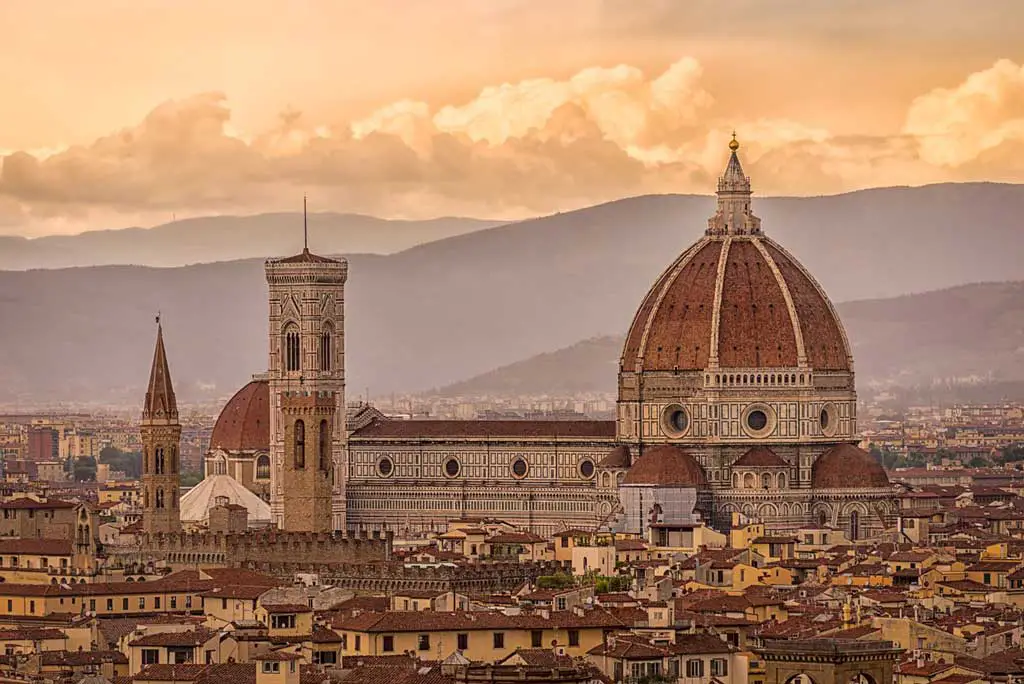
- Architect: Filippo Brunelleschi
- Location: Florence, Italy
- Construction: 1420-1436
- Style: Early Renaissance architecture
Although the entire design of the cathedral does not belong to the Renaissance period, the double shelled dome designed by Brunelleschi is one of the most important designs in Early Renaissance architecture.
The new structural technique he developed to design the gigantic dome became a source of inspiration for other Renaissance architects. The design and construction of this most famous dome of the Renaissance had lasted between 1420 and 1436.
2. Ospedale degli Innocenti
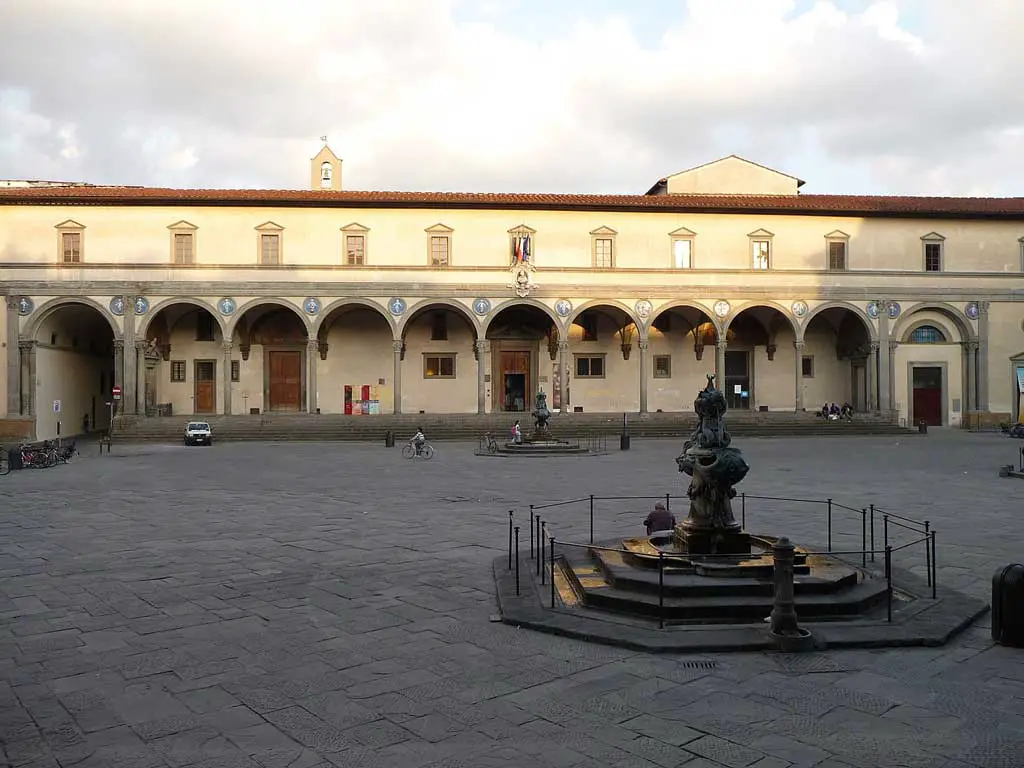
- Architect: Filippo Brunelleschi
- Location: Florence, Italy
- Construction: 1419-1445
- Style: Early Renaissance architecture
Brunellesci’s first architecture project Ospedale degli Innocenti was designed to be a house for orphan children in Italy. While the construction started in 1419, Brunelleschi held over as the architect of the project until 1927. It was finished by Francesco della Luna in 1445, with some changes in the project.
Brunelleschi’s major work in the building is the arcade with 9 arches. These arches sit on 10 elegant Corinthian columns. The Hospital of Innocents is the first building in Florence that makes a reference to classical architecture, with its columns and ornaments.
3. Pazzi Chapel
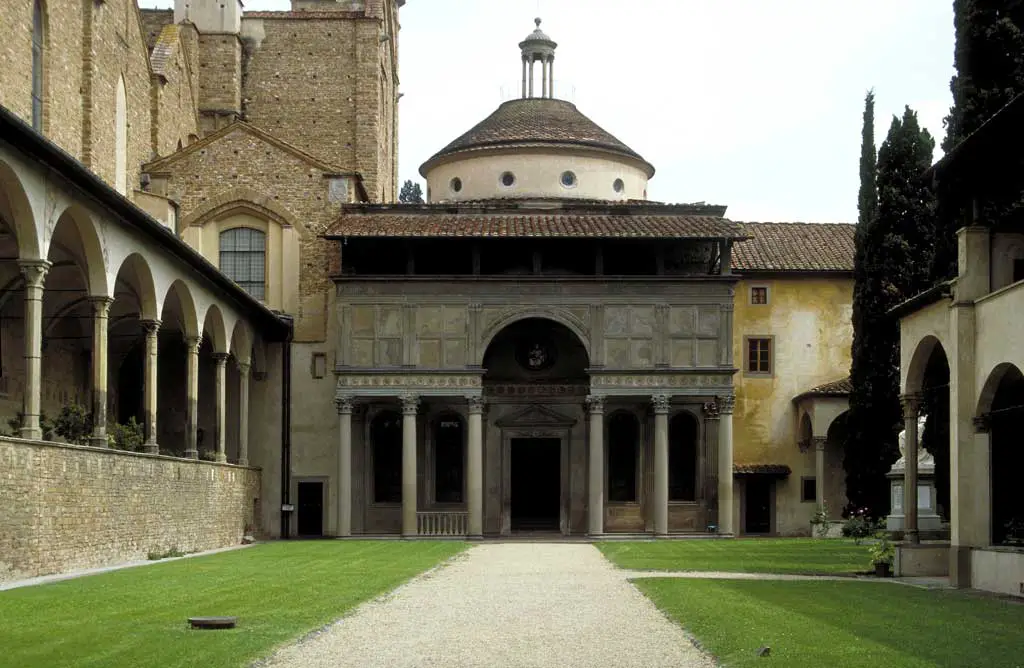
- Architect: Filippo Brunelleschi
- Location: Florence, Italy
- Construction: 1442-1443
- Style: Early Renaissance architecture
Brunelleschi’s Renaissance masterpiece, the Pazzi Chapel in Florence, was only completed after the architect’s death. The greenish colored sandstone called Pietra Serena was used extensively in the building.
Pazzi Chapel is in many ways reminiscent of the Pantheon Temple, one of the most important works of classical architecture.
We can see the oculus on the ceiling and many elements of classical architecture in the building which has an entrance with 6 Corinthian columns.
The dome of the building covers the rectangular interior. When we look at the ceiling of this rectangular area, we’ll see a dome that provides a fascinating light inside and a vault on each side.
In short, Brunelleschi designed one of the most unique structures in history, although it is very small in scale compared to many other Renaissance structures.
4. Basilica di Santo Spirito
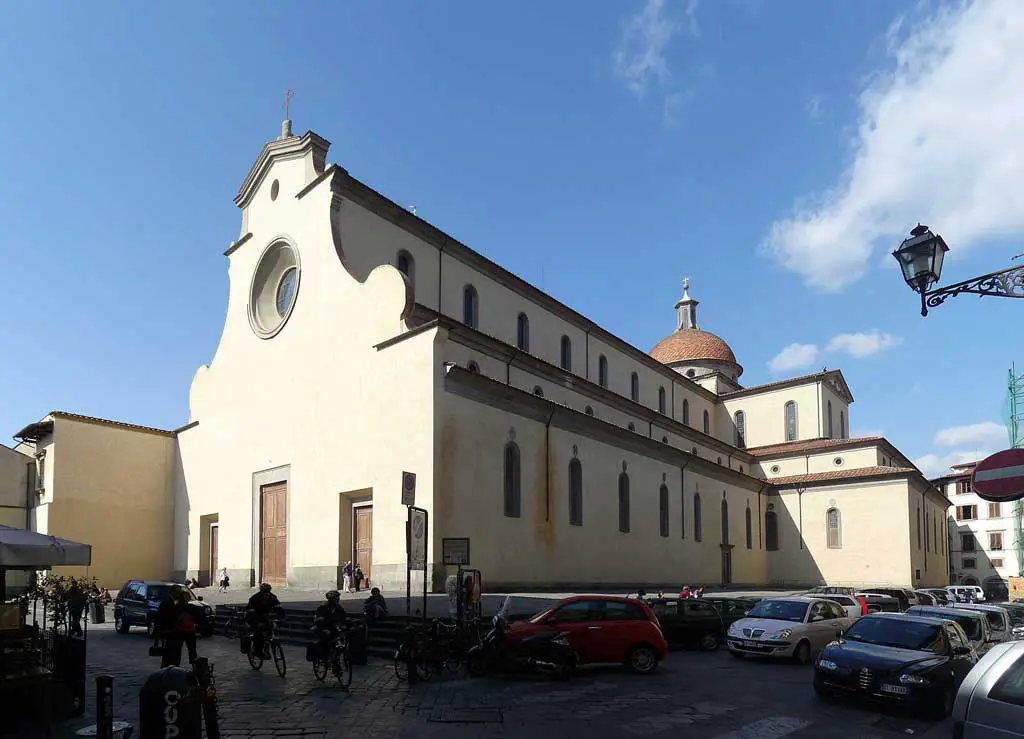
- Architect: Filippo Brunelleschi
- Location: Florence, Italy
- Construction: 1428-1487
- Style: Early Renaissance architecture
Santo Spirito Church designed by Brunelleschi, which is another Early Renaissance work, is located in Florence, the capital of the Renaissance.
The architect began designing this structure in 1428 on the site of the previously demolished church at the same site. After he died, his assistants continued the work and the construction of the dome.
There are some similarities between the Pazzi Chapel and Santo Spirito Church, designed by the same architect. The Pietra Serena stones covering the interior can also be seen here. But unlike Pazzi, Santo Spirito is a cruciform basilica.
Brunelleschi designed the form, width, height and openings of the building with a very rational geometric formula. It is possible to feel the integrity of these geometric proportions in the interior of the building.
The interior spaces designed with this rational mathematical method have created an almost perfect structure with the harmony of gray tones of plaster, green tones of sandstone and smooth geometric forms.
5. Tempio Malatestiano
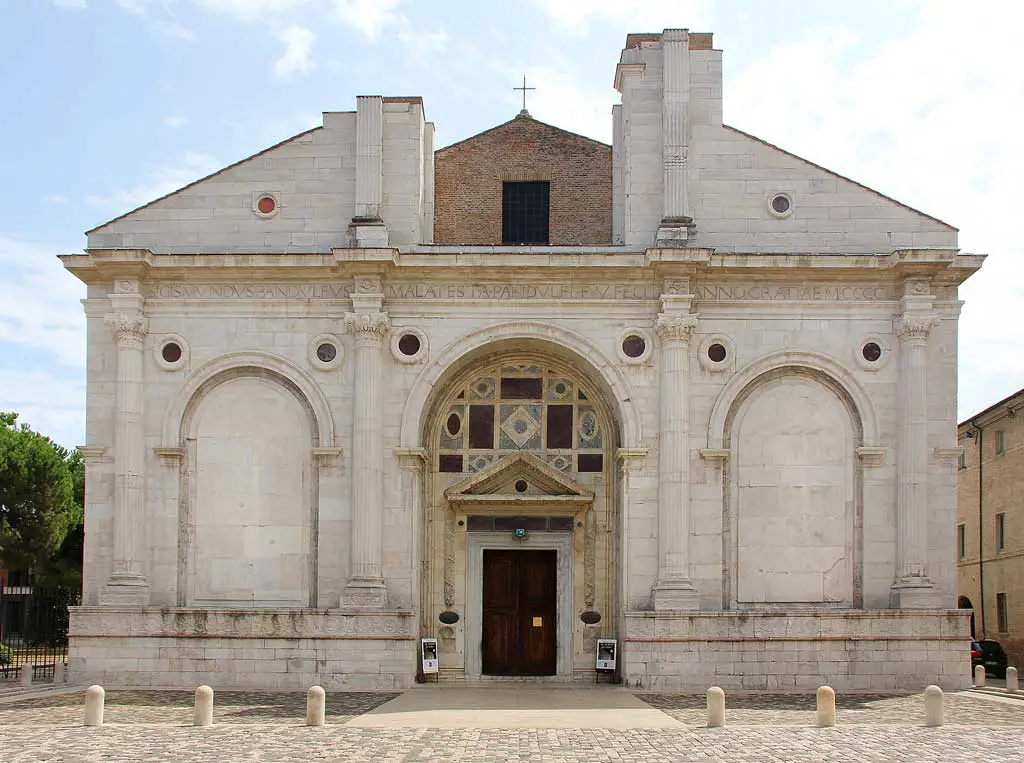
- Architect: Leon Battista Alberti
- Location: Rimini, Italy
- Construction: 1447-1453
- Style: Early Renaissance architecture
Alberti converted a Gothic chapel into a Renaissance structure in Rimini. It is a masterpiece of the High Renaissance in Italy despite its small scale.
The Malatesto family asked Alberti to make an eclectic reconstruction in the 1450s for the building, which was originally a 13th-century Gothic church.
Alberti designed a huge dome for the structure, but this was not applied. The upper part of the front of the building, which has a triangular pediment at the entrance and arcades on its sides, is also unfinished.
6. The Church of S. Andrea
- Architect: Leon Battista Alberti
- Location: Mantua, Italy
- Construction: 1470-1790
- Style: Renaissance architecture
Although this unique building by Alberti in Mantua was started in 1470, it was finished in 1790. There are 4 huge Corinthian pilasters, an eaves with frieze and a triangular pediment on the front facade.
In the center of this facade, an entrance arch that covers almost half of the facade stands out. This arch has Corinthian pilasters that extend towards the floor and are relatively smaller than the 4 side pilasters. This central arch extends the entrance space inwards and turns into a vault.
When we enter through the main entrance, we are greeted by the space with the largest barrel vault built since ancient Roman architecture (Dr. Horton). There are 3 chapels on both sides. These spaces are also covered with barrel vaults.
6. Tempietto Mausoleum
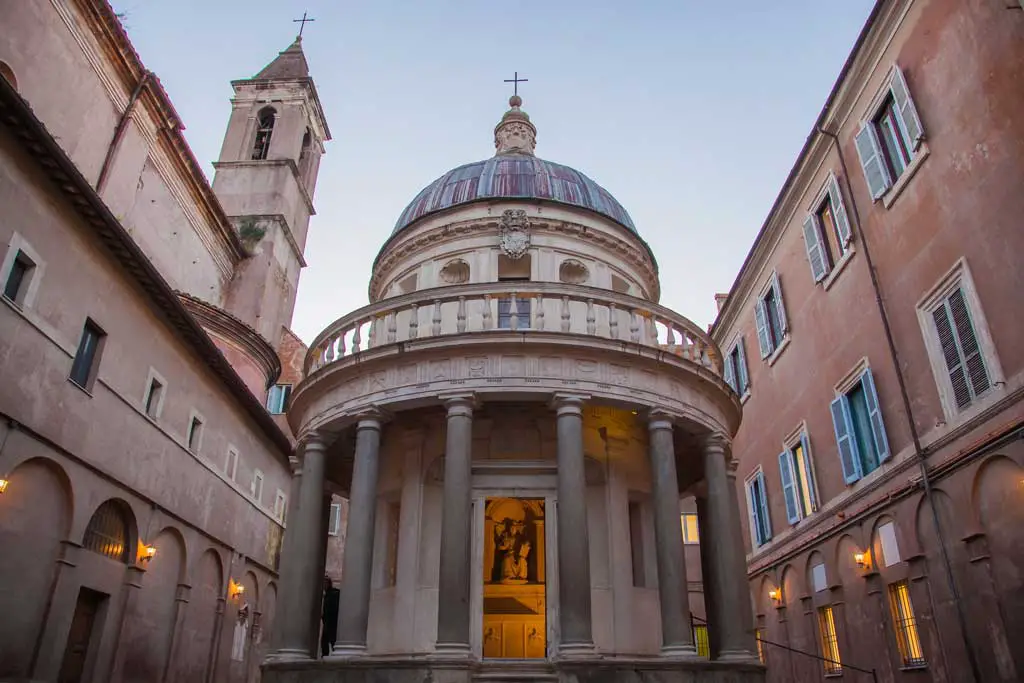
- Architect: Donato Bramante
- Location: Rome, Italy
- Construction: 1502
- Style: High Renaissance architecture
The mausoleum, designed by Donato Bramente, was built at the place where St. Peter was thought to be a martyr. Tempietto, which is a very small building, is among the most precious structures of Renaissance architecture style due to its architectural features.
The special importance that the symmetrical character of the Renaissance attributed to the circular form is the main characteristic shaping this building.
Bramente, who designed the temple in a circular plan, surrounded it with 16 Doric columns. The extremely small interior is covered with a hemispherical dome. Bramente’s aim was to design the building as a mausoleum to be viewed from the outside.
Frequently Asked Questions
A: Renaissance architecture is one of the major architectural styles that dominated European architecture in between the early 15th and 16th centuries.
A: Renaissance architecture taking inspiration from the architecture of antique Rome and Greece re-interpret classical architectural elements and implemented them in a more rational and comprehensive way.
A: Leonardo da Vinci, Raphael, Michelangelo and Donato Bramante are some famous Renaissance period artists.
A: Renaissance architecture originated in Florence, Italy. Then it spread to other cities in Italy and Europe.
A: Some most famous Renaissance architecture examples are Dome of Florence Cathedral, Pazzi Chapel, Basilica di Santo Spirito, Ospedale degli Innocenti, Tempietto, Tempio Malatestiano, Santa Maria Novella, Villa Rotonda, The Church of S. Andrea, Villa Farnese, Laurentian Library and Pallazo Ducale.
A: Filippo Brunelleschi, Leon Battista Alberti, Raphael, Donato Bramante, Leonardo da Vinci, Michelangelo, Andrea Palladio, Giulio Romano, Giacomo Barozzi da Vignola and Baldassare Peruzzi are some of the most prominent Renaissance architects.
A: Renaissance can be categorized into three stages, which are the Early Renaissance in 1400-1500, the High Renaissance in 1500-1520 and the Late Renaissance, also known as Mannerism, in 1520-1600.
Bibliography
Bodart, Diane (2008). Renaissance & Mannerism. New York: Sterling.
Chisholm, Hugh, ed. (1911), “Bramante”, Encyclopædia Britannica, vol. 4 (11th ed.), Cambridge University Press, p. 418
Franco Borsi. Leon Battista Alberti. New York: Harper & Row, (1977)
Klotz, Heinrich (1990). Filippo Brunelleschi: The Early Works and the Medieval Tradition. Translated by Hugh Keith. London: Academy Editions.
Partridge, Loren W. “Vignola and the Villa Farnese at Caprarola”, Part I The Art Bulletin 52.1 (March 1970:81-87)
The Renaissance: an Illustrated Encyclopedia, Octopus (1979)
Vitruvius, Ten Books on Architecture. Dover Publications



